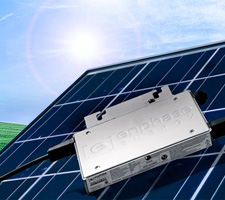 Solar panels are about to get more efficient, potentially boosting investment throughout the sector thanks to new technology that improves their ability to generate electricity from the sun.
Solar panels are about to get more efficient, potentially boosting investment throughout the sector thanks to new technology that improves their ability to generate electricity from the sun.
Microinverter maker Enphase Energy announced today that its microinverter technology will power 4.5 megawatts of solar projects developed and operated by Main Street Power and financed by Morgan Stanley. The news is the latest in a flurry of activity as the solar-optimization business heats up and solar companies look to maximize energy output of its systems.
“We included Enphase in our proposal because it offered substantial cost savings in system design, operation and maintenance, while also increasing energy harvest and system reliability,” said Eric Hinckley, senior vice president of Main Street Power. The Main Street project will sell energy generated to the San Diego Unified School District through a 20-year power purchase agreement.
Enphase is currently the leader in microinverter technology (pictured below), and the company says its technology can increase energy harvest by five to 25 percent. Other solar optimization players have been emerging with new product announcements as of late that also claim up to a 25 percent increase in solar power generated — SolarBridge and NEA-backed Azuray among them. SunPower and Suntech are among the panel manufacturers who are teaming with them to produce optimized panels.
 Here’s how microinverters work: Solar panels are connected in a series, so if one panel starts to fail or underperform (say, shade or dirt falls on it), it drags down output of the entire system because the entire system must be producing one consistent current — so total system output is defined by the weakest panel.
Here’s how microinverters work: Solar panels are connected in a series, so if one panel starts to fail or underperform (say, shade or dirt falls on it), it drags down output of the entire system because the entire system must be producing one consistent current — so total system output is defined by the weakest panel.
Microinverters solve this problem because they can be attached to individual panels, allowing them to function separately from the series. The microinverter converts the direct current (DC power) produced by the panels into the alternating current (AC power) used by the grid. Some integrate further ability to monitor, adjust and maximize panels through maximum power point tracking technologies (MPPT).
Panels that use solar-optimization technologies are termed “smart panels,” because they can react to underperforming panels and make adjustments to maximize energy production. Solar systems are already limited in how much sunlight gets converted into usable energy, so maximizing output and bringing down costs is an important issue for the viability of solar. Greentech Media has named microinverter and solar optimizers as “one of the strongest sub-segments for VC investors in solar.”
“For solar energy to become truly mainstream among residential and commercial sites, installation and operating costs must come down, and energy harvest must go up,” said Ron Van Dell, president and CEO of SolarBridge.
As of late, solar module manufacturers have been teaming with microinverter companies to produce these smart panels. In the past few days alone, companies have unstealthed and announced partnerships ahead of the Solar Power International conference starting tomorrow in Los Angeles:
- Last week, NEA-backed Azuray came out of stealth and announced a partnership with Renhe to incorporate its maximum power point tracking technology into the Chinese company’s solar junction boxes. It also announced a partnership with Suntech to research Azuray technology’s uses for smart panels. Azuray’s technology can generate up to 25 percent more energy than the system would otherwise produce.
- SolarBridge has partnered with Kyocera Solar and SunPower to integrate modules with a microinverter solution that replaces the junction box entirely, and is integrated onto the back of the solar module during the manufacturing process. It is offering a 25-year warranty for the modules, something others haven’t offered. Solar Bridge also says its technology can yield up to 25 percent more energy harvested.
- Suntech is also partnering with National Semiconductors to use National’s SolarMagic chipset to create smart panels. The company is also partnering with Enphase to research uses for Enphase’s technology in smart panels, which sounds like a similar deal to the Azuray one mentioned above.
- SunPower also announced today that it has formed a special interest group with SolarBridge and Tigo Energy to set standards within the solar optimizer field, in part to help lower total system costs.
 Are you a green executive or entrepreneur? If so, sign up now for GreenBeat 2010 — the year’s seminal conference on the smart grid — November 3-4 at Stanford University. World leaders in smart grid initiatives will debate how the new “Super Grid” is creating huge opportunities in cars, energy storage, and renewables. GreenBeat 2010 is hosted by VentureBeat and SSE Labs of Stanford University. Go here for full conference details and to apply for the 2010 Innovation Competition. Early-bird tickets are available until October 15th.
Are you a green executive or entrepreneur? If so, sign up now for GreenBeat 2010 — the year’s seminal conference on the smart grid — November 3-4 at Stanford University. World leaders in smart grid initiatives will debate how the new “Super Grid” is creating huge opportunities in cars, energy storage, and renewables. GreenBeat 2010 is hosted by VentureBeat and SSE Labs of Stanford University. Go here for full conference details and to apply for the 2010 Innovation Competition. Early-bird tickets are available until October 15th.
VentureBeat's mission is to be a digital town square for technical decision-makers to gain knowledge about transformative enterprise technology and transact. Learn More
